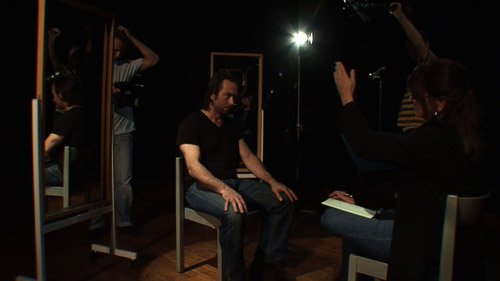
God damn Fosse!
Ingrid Blidberg
Dreamwork for actors with focus on Erik Ståhlberg's encounter with the method and Jon Fosse's play Warm.
My experience with theatre and my interest in dreams lead me to a new method that I introduced in Sweden 2009: Dreamwork for Actors. It's been developed by Janet Sonenberg a professor at MIT and Robert Bosnak a Jungian dream therapist. The method is based on enriching your artistic work, firmly establishing it in your body and strengthening your own intuition. Three actor and one director worked with the play Warm by Jon Fosse and a couple of weeks in to the rehearsals Sonenberg and Bosnak showed up to work with them. A large portion of the work was documented by two cinematographers.
As a platform for the project I had my master studies from The School of Film Directing and The Academy of Music and Drama. Folkteatern in Gothenburg leant me one of their actors.

The method in a nutshell.
The actor/director describes a part of the artistic process that need working on for the dreamworker. It can be a question to your character, the directors vision or an image. The dreamworker looks at the story as a dream and places the actor in a hypnagogical state, the closest you can come to your dream world while not sleeping. The ongoing work takes about 30 minutes. The actor gets help getting into the image, then you study the emotions that this image awakens and establish them in your body. By weaving together images, emotions and the body, the specific points at where they have shown up are strengthened and an emotional memory is created. The actor is encouraged to slow down, come closer and let the images unfold and enter the perspective of others. The dreamworker creates a network of emotional memories in different parts of the body. 5-6 points are what can usually be kept going at the same time.
After the work is finished the actor is given a stick figure where the place on the body is pointed out, the recalled emotion and what characters perspective you've worked with. With the help of this drawing you can activate emotional memories just before falling asleep. The concentrated work with the dreamworker and the activation before going to bed attracts a dream. Even those who never remember their dreams will do so now. It's important to write down what you dream as soon as you wake up or it will disappear.
The next step is to describe your dream and then get guided through it in the same way you where with the original question. After about 30 minutes and 5-7 emotional memories you are completely exhausted since the process requires complete presence and concentration. The dream world has opened up and enriched the artistic process in an unconscious way. Belief in your own creativity is strengthened as well as a trust in the signals your body sends you. As a scriptwriter you can study a place in your text where you've got stuck, a director can get in physical contact with his directors vision and an artist with his image.
What differs this method and exercises from others, when it comes to developing your creativity, is how you enter a perspective of the other. If you in a dream run away from a monster you get access to both the person running away and the monster itself. By identifying with the monster you usually meet a very sad figure who wishes to bond. This double perspective breaks up our usual habits of seeing and induces a new and fresh approach.
The introduction a success. Then what happened?
Since the spring of 2010 the actors studying at The Academy of Music and Drama can work with this method, if so acquired. Their curiosity has been awakened after seeing Warm and after having attended seminars about the method. One of the participants in the project, Per Nordin, is the main teacher in stage performance at The Academy of Music and Drama. He works with the students who want to try the method. During the autumn 2010 another participant in my project, the actress Anna Söderling, started her masters degree at The Academy of Music and Drama. She also works with guiding students who are interested through the process. I myself have taken part in different courses with Robert Bosnak to help develop my ability to work with others. So now there are three of us in Sweden starting to understand the difficult art of guiding others through their own artistic processes. In August 2012 Janet Sonenberg and Robert Bosnak will come back to Sweden for a week long workshop. 15 artists from different fields will participate. The initiate circuit widens.
I am now working on a longer cinematic interpretation of my documentation of the method. In conversation with scientists, designers and craftsmen I have found that within all these fields there is an interest to get a deepened contact with the problems they struggle with. It feels like we're just at the start of something that can grow and give better artistic self-confidence and a stronger presence in the artistic expression.
Robert Bosnak on Dreams and Imagination